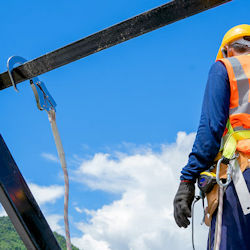The Anchorage
An anchorage is a secure point of attachment for lifelines, lanyards, or deceleration devices.
Fall Arrest System Components
How can you be sure that an anchorage is secure? An anchorage for a personal fall-arrest system must support at least 5,000 pounds. Anchorages that can't support 5,000 pounds must be designed and installed under the supervision of a qualified person and must be able to maintain a safety factor of at least two - twice the impact force of a worker free-falling 6 feet. If you don't know how much weight an anchorage will support, have a qualified person check it before you trust your life to it.
Anchorage strength is critical, but is not the only factor to consider. It's also important to consider:
- Anchorage connector: Unless an existing anchorage has been designed to accept a lanyard or lifeline, you'll need to attach an anchorage connector - a device that provides a secure attachment point. Examples include tie-off adapters, hook anchors, beam connectors, and beam trolleys. Be sure that the connector is compatible with the lanyard or lifeline and appropriate for the work task.
- Attachment point: The anchorage can be used only as the attachment point for a personal fall-arrest system; it can't be used to support or suspend platforms.
- Location: The anchorage should be located directly above the worker, if possible, to reduce the chance of a swing fall.
- Fall distance: Because a personal fall-arrest system doesn't prevent a fall, the anchorage must be high enough above a worker to ensure that the arrest system, and not the next lower level, stops the fall. Consider free-fall distance, lanyard length, shock-absorber elongation, and body-harness stretch in determining the height of an anchorage. Free-fall distance is the distance a worker falls before a personal fall-arrest system begins to stop the fall.
- Connectors: An anchorage, a lanyard, and a body harness are not useful until they're linked together. Connectors do the linking; they make the anchorage, the lanyard, and the harness a complete system. Connectors include carabiners, snap hooks, and D-rings.
- Carabiner: This high-tensile alloy steel connector has a locking gate and is used mostly in specialized work such as window cleaning and high-angle rescue. Carabiners must have a minimum tensile strength of 5,000 pounds.
- Snap hook: A hook-shaped member with a keeper that opens to receive a connecting component and automatically closes when released. Snap hooks are typically spliced or sewn into lanyards and self-retracting lifelines. Snap hooks must be high-tensile alloy steel and have a minimum tensile strength of 5,000 pounds. Use only locking snap hooks with personal fall-arrest systems;locking snap hooks have self-locking keepers that won't open until they're unlocked.
- D-ring: D-rings are the attachment points sewn into a full-body harness. D-rings must have a minimum tensile strength of 5,000 pounds.
Knowledge Check Choose the best answer for the question.
5-5. What has a high-tensile alloy steel connector and a locking gate?
You forgot to answer the question!

